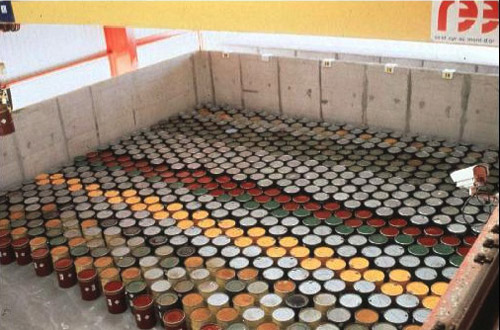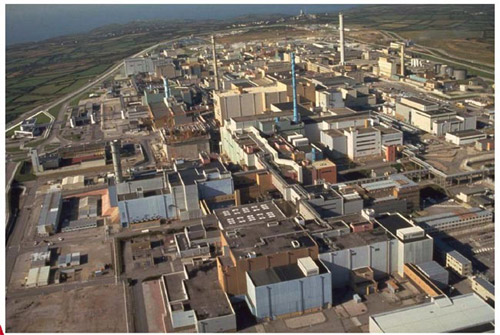Radioactive waste strikes fear into the layman. However, not a single fatal accident relating to transportation, storage or disposal of such waste has occurred to date. In France, only 2 grams of high-level waste (the most hazardous category) are produced per capita per year. This figure is low when one considers that French nuclear power plants generate around 80% of the country’s electricity. However, the management costs and risks relating to this waste are disproportionate to its volume!

Five waste management categories
The radioactive waste management strategy must cover low-level waste as well as highly radioactive substances. The volumes to be managed are inversely proportional to their degree of radioactivity.
© ANDRA
Radioactive waste is classified into two categories: waste for which a management strategy has been defined; and waste for which no permanent solution has yet been adopted, which is not to say that none exists.
The first category consists of the most voluminous and least radioactive waste, for which final respositories already exist.
The second category mainly consists of the most radioactive waste, for which management-oriented research is being conducted, due to the risks involved. This category also includes certain types of low-level waste for which solutions have not yet been implemented.

Above-ground disposal of low-level radioactive waste
Low-level radioactive waste is disposed of at specialised above-ground repositories. The photograph shows the disposal of metal drums containing low- and intermediate-level short-lived waste at the CSA repository in the Aube department. Metal drums are stored in a disposal cell, and the gaps between drums filled with gravel. When a cell is full, it is closed off by a concrete slab and covered with a layer of impermeable polyurethane plastic to seal it.
© ANDRA
In France, the Areva plant in La Hague, near Cherbourg, plays a key role in high- and intermediate-level waste production and conditioning. The plant also features several interim storage facilities. Additional storage facilities exist in Marcoule, in the Gard department.
Research efforts focus in particular on waste conditioning and disposal. Solutions have already been proposed in these areas. For example, high-level waste generated at the La Hague plant can be reliably contained using proven industrial vitrification technology, protecting the environment for at least 10,000 years. Nevertheless, however well conditioned, a solution must be defined for the final disposal of such waste in stable, deep-lying geological formations.
No country currently operates final disposal sites for high-level irradiated fuel or glass from reprocessing activities. These hazardous materials are currently either stored in a dispersed manner near power plants, as in the USA, or else centralised at a small number of specialised sites, as in France and Sweden.

La Hague – a specialized plant for high-level radioactive waste
In France, spent fuel from reactors, containing the most highly-radioactive substances, is processed at facilities in the La Hague plant after being allowed to cool for several years in storage pools. This processing isolates the recoverable uranium and plutonium. The residual substances, considered to be waste, are vitrified and then stored pending a decision regarding their final destination. Intermediate-level waste is also processed, conditioned and stored at La Hague. Non-reprocessed fuel is also stored.
© AREVA
Transportation of radioactive material, particularly high-level material, is another topic about which concerns have been voiced. Certain environmental protection organisations are fiercely opposed to such transport movements. Does this mean that we must permanently store this waste in inhabited areas, near waterways?. Is it not better to transport it, subject to the necessary precautions, to a safe location?
The decision-making process regarding deep geological disposal of high-level waste is a lengthy one, as illustrated by the choice of a site under Yucca Mountain in Nevada, USA, subsequently rescinded in 2010.
Research efforts have yielded progress in terms of conditioning and immobilising radioactivity. Decision-making delays have conveyed a false impression that no solutions exist. Delays would become disastrous if indecision were allowed to reign. Certain parties opposed to burying waste express legitimate fears. Others have acted out of more down-to-earth interests: “not in my backyard” (NIMBY) is an age-old knee-jerk response by no means unique to radioactive waste.
Articles on the subject « Waste management »
Waste management status
Repositories already in operation for low-level waste Compared with other types of waste, the mas[...]
Other storage facilities
Interim waste storage according to their nature and origin Spent fuel and vitrified waste from Pr[...]
Temporary storage
A temporary solution Interim storage is a temporary solution that plays a central role in the man[...]
Vitrified waste Storage
Dry storage of vitrified waste Spent nuclear fuel assemblies are not the only materials removed f[...]
Spent fuel storage
Interim storage in pools and then dry locations In all countries, spent fuel management begins wi[...]
Management outside France
Overview of waste management strategies outside France Management of the least radioactive waste [...]
LILW-SL waste repository
Disposal of low and intermediate-level short-lived waste Low and intermediate-level short-lived w[...]
VLLW repository
An operational repository for very low-level waste The second category of waste for which a repos[...]
High level waste transportation
Moving highly radioactive materials The 10% of transport movements that concern high-level radioa[...]
Transport safety
Measures to ensure safe transport Nuclear materials may be highly radioactive. The goal is to pre[...]